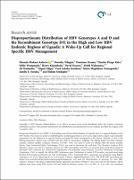| dc.description.abstract | Background. Hepatitis B virus (HBV) is the leading cause of liver-related diseases. In Uganda, there is a regional disparity in the
HBV burden. Our study was aimed at establishing the circulating genotypes in a low and a high endemic region to give plausible
explanations for the differences in regional burden and guide the future management of the disease. Methods. A total of 200
HBsAg-seropositive subjects were recruited into the study by convenience sampling. The HBsAg Rapid Test Strip (Healgen
Scientific Limited Liability Company, Houston, TX77047- USA) was used to screen for HBsAg while the Roche machine
(Roche, Basel Switzerland/Abbot Technologies (USA)) was used to determine the viral load. The Chemistry Analyzer B120
(Mindray, China) was used for chemistry analysis. For HBV genotyping, total DNA was extracted from whole blood using the
QIAamp® DNA extraction kit. Nested PCR amplification was performed using Platinum Taq DNA Polymerase (Invitrogen
Corporation, USA) to amplify the 400 bp HBV polymerase gene. Purification of nested PCR products was performed using
Purelink PCR product purification kit (Life Technologies, USA). Automated DNA sequencing was performed using BigDye
Terminator v3.1 Cycle Sequencing Kit on 3130 Genetic Analyzer (Applied Biosystems, USA). The NCBI HBV genotyping tool
(https://www.ncbi.nlm.nih.gov/projects/genotyping/formpage.cgi) was used for determination of genotype for each HBV
sequence. Pearson’s chi-square, multinomial logistic regression, and Mann–Whitney U tests were used for the analysis. All the
analyses were done using SPSS version 26.0 and MedCalc software version 19.1.3 at 95% CI. A p < 0:05 was considered
statistically significant. Results. Majority of our study subjects were female (64.5%), youth (51.0%), and married (62.0%). Overall,
genotype A was the most prevalent (46%). Genotype D and the recombinant genotype D/E were proportionately more distributed
in the high endemic (38.2%) and low endemic (36.5%) regions, respectively. Genotype D was significantly more prevalent in the
high endemic region and among the elderly (p < 0:05). Genotype D was significantly associated with elevated viral load and direct
bilirubin (p < 0:05). The recombinant genotype D/E was significantly associated with elevated viral load (p < 0:05). Similarly,
genotype A was significantly associated with elevated AST and GGT, lowered viral load, and normal direct bilirubin levels
(p < 0:05). Conclusion. There is disproportionate distribution of genotypes A and D and the recombinant genotype D/E in the
low and high endemic regions of Uganda. This probably could explain the differences in endemicity of HBV in our country
signifying the need for regional specific HBV management and control strategies. | en_US |

